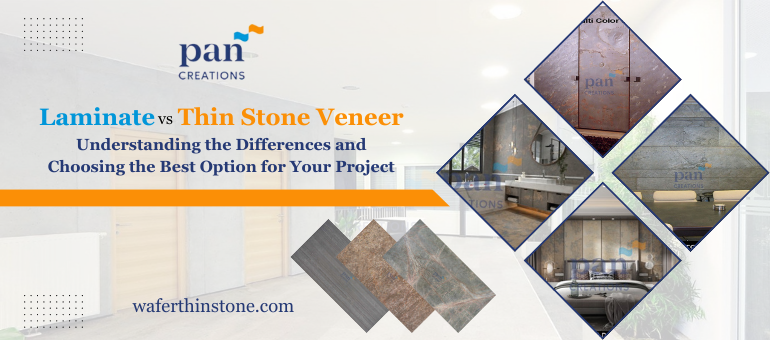What is the Distinction Between Laminate and Veneer?
In the realm of furnishing and interior design, the quandary of selecting the optimal finish often revolves around two prominent contenders: laminate and thin stone veneer. Both materials tout distinct advantages and aesthetic allurements that can elevate the ambiance and allure of your living spaces. This discourse aims to dissect the disparities between laminate and thin stone veneer, delving into their composition, resilience, upkeep, and economic viability. Armed with a comprehensive understanding of these pivotal distinctions, you’ll be empowered to make a judicious choice that harmonizes with your precise requisites.
Deciphering Laminate:
Composition and Aesthetic Charisma
Laminate epitomizes an artificial concoction, crafted by amalgamating layers of flat paper and plastic resins under intense heat and pressure. The topmost stratum, known as decorative paper, imparts color or intricate patterns to the laminate. This versatile medium boasts an extensive spectrum of hues, textures, and finishes, rendering it a ubiquitous choice across diverse applications, spanning furniture, cabinetry, and interior surfaces.
Visual and Tactile Resonance
In stark contrast to natural elements such as wood or stone, laminate emerges as a synthetic progeny adept at emulating their semblance with remarkable fidelity. Textured laminates, for instance, adeptly replicate the intricate grain patterns and textures synonymous with wood, providing a pocket-friendly alternative to solid wood furnishings. The glossy veneers exude a sleek, contemporary aura, whereas their matte counterparts exude subtlety and understated elegance.
Resilience and Maintenance
A salient virtue of laminate lies in its inherent durability, endowed with the capacity to withstand the rigors of daily wear and tear. Resistant to scratches, stains, and moisture incursions, laminate emerges as an ideal candidate for areas besieged by foot traffic or susceptible to spillage. Maintenance demands are minimal, necessitating periodic dusting and sporadic swabbing with a damp cloth. Nonetheless, abrasive cleansers and scouring implements are best eschewed to avert surface abrasions.
Economic Dynamics
From an economic vantage point, laminate tends to outshine its natural counterparts in terms of affordability. Price differentials hinge upon variables such as quality, brand cachet, and design intricacy. Yet, even premium-grade laminates remain relatively pocket-friendly vis-à-vis their organic analogs. This fiscal prudence renders laminate an enticing proposition for those endeavoring to realize specific aesthetic visions without incurring exorbitant costs.
Must read: Stone Veneer Installation: A Comprehensive Guide for Architects and Builders
Decoding Thin Stone Veneer:
Composition and Aesthetic Allure
Thin stone veneer, colloquially known as natural stone veneer, embodies a wafer-thin layer of genuine stone affixed to a supportive substrate, be it fiberglass or resin. This innovative construction modality facilitates expedited installation procedures while mitigating the bulk and expense associated with traditional full-thickness stone installations. Thin stone veneer epitomizes the timeless allure and sophistication of natural stone, proffering a kaleidoscope of design possibilities.
Visual and Tactile Resonance
Derived from authentic stone quarries and meticulously fashioned into slender slivers, thin stone veneer exudes an air of authenticity underscored by its intrinsic heterogeneity in color, texture, and veining. Whether your aesthetic predilections veer toward the rugged charm of stacked stone or the opulent grandeur of marble, thin stone veneer confers an extensive array of options to manifest your design fantasies.
Resilience and Maintenance
A cornerstone of thin stone veneer’s appeal resides in its robust durability, emblematic of natural stone’s indomitable fortitude. Resilient against abrasions, fading, and inclement weather, thin stone veneer endures the ravages of time with stoic grace. Albeit endowed with innate sturdiness, certain stone varieties may necessitate periodic sealing to safeguard against blemishes and preserve their pristine allure.
Economic Dynamics
In juxtaposition to laminate, thin stone veneer tends to command a premium owing to the exigencies of procuring and processing natural stone. Cost dynamics are contingent upon factors such as stone variety, veneer thickness, and installation intricacies. Notwithstanding the initial investment outlay, the enduring splendor and longevity of thin stone veneer warrant its categorization as a judicious long-term investment.
Must read: The Advantages of Thin Stone Veneer for Interior Design
Laminate vs Thin Stone Veneer: Electing the Superlative Finish

When navigating the labyrinth of choices between laminate and thin stone veneer, a multiplicity of factors warrants consideration, spanning aesthetic predilections, durability imperatives, maintenance exigencies, and fiscal constraints. To facilitate a well-informed decision-making process, let us juxtapose these two finishes across pivotal domains:
Aesthetic Diversity
Laminate proffers a kaleidoscopic array of hues, textures, and finishes, affording boundless scope for customization and design articulation. Whether your inclinations gravitate toward the sleek allure of high gloss or the rustic nostalgia evoked by wood grain textures, laminate adeptly caters to disparate aesthetic sensibilities. Conversely, thin stone veneer bestows the organic allure and idiosyncratic charm of genuine stone, replete with nuanced tonal variations and tactile resonance.
Durability and Maintenance
Laminate emerges as a paragon of durability, impervious to scratches, stains, and moisture incursions. Maintenance imperatives are minimal, necessitating no more than sporadic dusting and intermittent swabbing. In contrast, while thin stone veneer mirrors laminate’s resilience, certain stone variants may mandate periodic sealing to fortify against stains and preserve aesthetic integrity. Nonetheless, the innate fortitude of natural stone furnishes an enduring safeguard against the vagaries of time.
Economic Considerations
Laminate’s economic allure lies in its affordability vis-à-vis natural materials, rendering it an appealing option for budget-conscious consumers. Conversely, while thin stone veneer entails a heftier upfront investment, its longevity and aesthetic opulence underscore its status as a judicious long-term investment.
Application and Versatility
Laminate’s versatility finds expression across a panoply of applications, spanning furniture, cabinetry, countertops, and wall surfaces. Its facile installation and adaptability render it a staple choice for residential and commercial ventures alike. Conversely, while thin stone veneer may lack the ubiquity of laminate, its capacity to engender captivating accents, feature walls, and fireplace surrounds imbues any space with an aura of opulence and sophistication.
In Conclusion:
The conundrum of selecting between laminate and thin stone veneer is contingent upon a nuanced appraisal of your unique requisites, preferences, and budgetary constraints. While laminate proffers an extensive palette of colors, finishes, and facile maintenance, thin stone veneer emanates the timeless allure and enduring durability of genuine stone. Whether prioritizing cost-effectiveness or aesthetic opulence, the judicious selection of the ideal finish hinges upon a holistic evaluation of your exigencies and aspirations.
How Can Pan Creations India Assist You?

At Pan Creations India, we stand as a paragon of excellence in the realm of flexible stone veneer, thin stone, real sandstone, UV translucent, fabric backing, and mosaic products. Our expansive repertoire of premium finishes and customizable options epitomizes the pinnacle of aesthetic refinement, facilitating the realization of your design aspirations with unparalleled finesse. Embark on a transformative journey of aesthetic elevation by perusing our diverse product offerings today.

